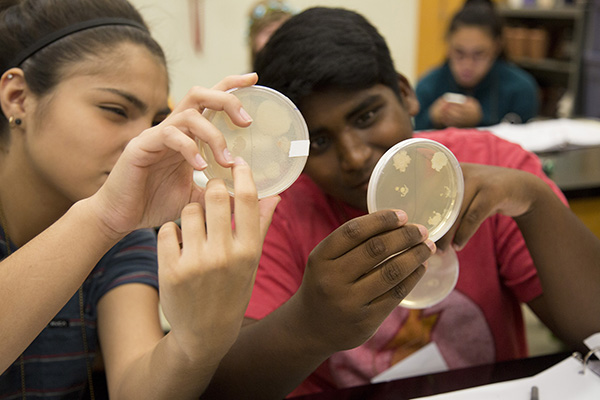 New approaches to training teachers of math and science are expected to have significant impact on K-12 students. (Sacramento State file photo)
New approaches to training teachers of math and science are expected to have significant impact on K-12 students. (Sacramento State file photo)When California adopted a new set of K-12 math and science teaching standards – formally known as the Common Core Standards for Mathematical Practice and the Next Generation Science Standards – there was just one problem: Teachers weren’t given the resources to implement them in a timely fashion.
The resulting challenge was determining how Sacramento State and other universities involved in teacher training could ready their faculty and classroom supervisors to prepare teacher candidates to teach to the new standards.
“This is a sea change in the way that science and math are expected to be taught,” says Pia Wong, associate dean for the College of Education. “Teachers are being asked to teach in a way they never learned, in subjects in which they may not feel as confident as they need to be to teach these fairly ambitious standards.”
But a five-year, $3.5 million U.S. Department of Education Teacher Quality Partnership grant is helping. With that funding, Sacramento State is launching a program called STEM-POWER that will bring together University faculty and local school district staff to develop, implement and assess best practices for implementing the new standards.
The goal is to ensure professionals involved with teacher preparation in the Sacramento region have tools and skills they need to train the next generation of high-quality science and math teachers.
“Sacramento will soon become the place where great K-12 STEM teaching and learning happens,” Wong says.
New standards emphasize core math and science ideas and concepts designed to provide K-12 students with a solid foundation in scientific mathematical processes and deepen interest in STEM fields. That's a departure from previous standards that focused on teaching those students a seemingly endless stream of facts and figures.
For three years, Sacramento State and the Sacramento City School District together have considered the new standards and how to implement them.
“We had never had all of those stakeholder groups in the same room together before,” says Sue Baker, a professor of education and project director for STEM-POWER. “It was knowledge building and capacity building, but also trust building and community building.”
The STEM-POWER group includes approximately 25 Sacramento State faculty from the colleges of Education, Natural Sciences and Mathematics, and Engineering and Computer Science; Sac State classroom supervisors; and school district administrators responsible for professional development. The group will build on the earlier conversations by looking closely at best practices, taking them into the classroom, assessing their effectiveness, and shaping teacher preparation programs for the University and districts to implement.
For example, the new standards indicate that teachers should engage their students in high-quality classroom discussions, an approach previously avoided out of concern that is was a waste of class time, Baker says. The STEM-POWER grant will provide the University and districts with resources needed to evaluate strategies for implementing these discussions, such as specific prompts or grouping strategies, to determine which are most effective. That then can be taught to teacher candidates.
The hoped-for result of the new-teacher training, Baker says, is a ripple effect that improves science and math education for all students in the area.
“Every time we bring a new student teacher on board and mentor them, that student teacher is going to work with easily 600 students over their career,” Baker says. “There’s a tremendous impact that this program can have.”
Similar to the standards themselves, Sacramento State’s preparation is focusing and sharpening the skills teaching candidates are taught to help them better connect classroom theory with experiences they will encounter as teachers.
“The reality is we cannot prepare them for every situation they’re going to run into,” Wong says. “We’re actually much better off providing them with a really solid core set of practices they can enact in any situation.”
The grant funding will primarily pay for stipends and release time for Sacramento State faculty and partner district teachers and staff involved with the project.
Go to the College of Education's web page for more information. – Jonathan Morales
